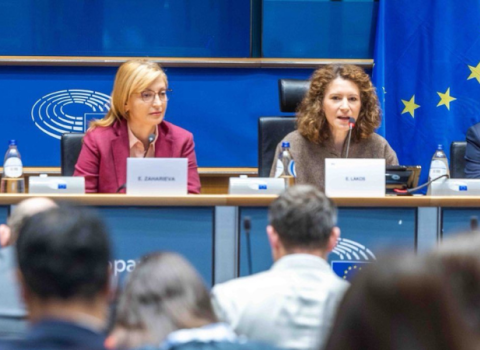“These are difficult days for Ireland,” said Máire Geoghegan-Quinn, Commissioner for Research, Innovation and Science, addressing her compatriots in a speech at Dublin City University this week.
Speaking as the Irish government was negotiating a €85 billion loan, whilst simultaneously preparing spending cuts and tax increases worth €15 billion to add to €15 billion cuts made over the past two years, Geoghegan-Quinn expressed her “absolute confidence” in Ireland's ability to “build a positive future for itself.”
Here, in some highlights from the speech, Geoghegan-Quinn lays out in detail how the EU envisages its science and innovation policies helping Ireland and Europe’s other battered economies to get back on their feet.
“Against the backdrop of the serious economic and financial crisis, and the implementation of austerity measures in many countries, I am more convinced than ever that innovation is the key to a stable European economy, to growth and job creation.
We are being ambitious - we need innovation in every walk of life, not just in the laboratory or the factory. Not just in the most prosperous regions, but in cities and rural areas across the whole European Union. Not just research-driven innovation, but innovation in business models, management structures and processes, design and marketing.
Nor is innovation limited to the private sector; it must happen too in our public sector, in our hospitals and our schools, and in government itself.
Innovation needed to generate product and services
We need to reach the target of 3 per cent of GDP spending on R&D that has been re-confirmed by Europe 2020. But we will not reach our goal without the right economic and regulatory conditions. And reaching it will only make sense if, through innovation, we transform ideas into new products and services that people actually want, and into new jobs for Europeans.
We also need to be more innovative to tackle the major challenges faced by our society now and in the coming decades, such as fighting climate change, healthy living for the growing number of older people in Europe, and using scarce resources more efficiently.
The solutions to these challenges can present enormous commercial opportunities for European companies.
The first pillar of the Innovation Union is reform of higher education. Irish universities are forward-looking, but they need to develop even better links with European partners and become even more business-focused. It is time to go one step further and build new forms of cooperation across borders and across sectors, time to bring together business and academia, time to build up on innovation along the whole policy chain, from research to retail.
The synergies produced by world-class universities, research organisations and international companies can develop into a growing innovation eco-system where local start –ups and SMEs can thrive.
We need to create the conditions to grow the research base alongside manufacturing. The presence of a big international player can often create an ecosystem of start-ups and SMEs around it, where innovation can thrive.
These considerations are all addressed in the Innovation Union Flagship. I am determined, for example, to ensure that the EU's Framework Programme for Research will continue to provide the much-needed investment in research on which innovation is based.
EU Patent must be agreed
We must make it easier for researchers and companies – SMEs in particular – to access funding. We will streamline the funding process and take better account of the intrinsic risks associated with research and innovation projects. We also need to improve the use of Structural Funds to boost research and innovation capacities in the Member States and their regions. I think we should encourage their implementation as part of smart specialisation strategies.
The EU patent needs to be quickly agreed. We will look into all the possible options to ensure that a breakthrough is finally achieved. Also a European market for patents and licensing could be developed, modelled on good practices in Member States such as France and Denmark.
We should also review Europe's standardisation system in order to speed up the setting of standards in key sectors that underpin innovation.
Opening up the flow of knowledge
At the same time, the ever more rapid deployment of new information and communication technologies speeds up the transmission of knowledge and makes collaboration easier and more efficient. Now and in the future, companies cannot afford to rely on just their own employees for knowledge.
We need to remove obstacles to the cross-border flow of people, ideas and funding. This open circulation of information, and based on this, open innovation, are goals of the Innovation Union Flagship. We need to foster more open innovation. We must embrace new ways of sharing knowledge – knowledge and know-how is more evenly distributed around the world.
Cooperation between the world of research and the world of business must be enhanced, obstacles removed and incentives put in place. We will provide the means for simpler and cheaper management of intellectual protection to reduce costs for researchers and companies.
Once companies embrace innovation, they can find their capacity to develop and expand, particularly internationally, is hampered by limited access venture capital. Another obstacle to innovation is the shortage of higher risk loans to our most innovative companies. Banks do not put a value on knowledge assets, such as intellectual property, and so are often unwilling to invest in knowledge-based companies.
At EU level, the current Risk Sharing Finance Facility (RSFF) under FP7 and the financial instruments of the Competitiveness and Innovation Framework Programme (CIP) have leveraged investments worth more than twenty times the contribution from the EU Budget, and have been unable to keep up with the great demand. However, we need to ensure that more SMEs participate in these programmes.
The expertise and market standing of the European Investment Bank (EIB) Group in managing these financial instruments has been a major factor in their success. The European Commission will work with the European Investment Bank, national financial intermediaries and private investors to develop proposals to bridge the funding gaps for all companies, but especially for SMEs and start-ups.
The European Commission will also work to make it easier to invest across borders by ensuring that venture capital funds established in one Member State can invest freely anywhere in the EU.
Use public procurement to drive innovation
We must also harness our large procurement budgets for the purposes of innovation, as they do so effectively in the United States. For highly innovative companies, it is very important to have a large reliable buyer prepared to purchase their products.
What is needed, therefore, is nothing less than a fundamental re-alignment of procurement policy. Member States need to set aside part of the procurement budgets for pre-commercial or innovative procurement.”
(This is an edited version of a speech by Máire Geoghegan-Quinn at Dublin City University on 22 November.)




 A unique international forum for public research organisations and companies to connect their external engagement with strategic interests around their R&D system.
A unique international forum for public research organisations and companies to connect their external engagement with strategic interests around their R&D system.